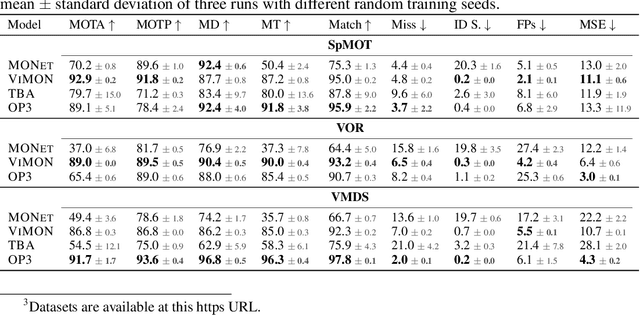Unmasking the Inductive Biases of Unsupervised Object Representations for Video Sequences
Paper and Code
Jun 12, 2020



Perceiving the world in terms of objects is a crucial prerequisite for reasoning and scene understanding. Recently, several methods have been proposed for unsupervised learning of object-centric representations. However, since these models have been evaluated with respect to different downstream tasks, it remains unclear how they compare in terms of basic perceptual abilities such as detection, figure-ground segmentation and tracking of individual objects. In this paper, we argue that the established evaluation protocol of multi-object tracking tests precisely these perceptual qualities and we propose a new benchmark dataset based on procedurally generated video sequences. Using this benchmark, we compare the perceptual abilities of three state-of-the-art unsupervised object-centric learning approaches. Towards this goal, we propose a video-extension of MONet, a seminal object-centric model for static scenes, and compare it to two recent video models: OP3, which exploits clustering via spatial mixture models, and TBA, which uses an explicit factorization via spatial transformers. Our results indicate that architectures which employ unconstrained latent representations based on per-object variational autoencoders and full-image object masks are able to learn more powerful representations in terms of object detection, segmentation and tracking than the explicitly parameterized spatial transformer based architecture. We also observe that none of the methods are able to gracefully handle the most challenging tracking scenarios, suggesting that our synthetic video benchmark may provide fruitful guidance towards learning more robust object-centric video representations.
 Add to Chrome
Add to Chrome Add to Firefox
Add to Firefox Add to Edge
Add to Edge